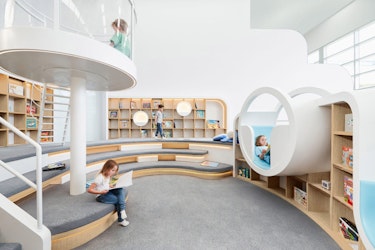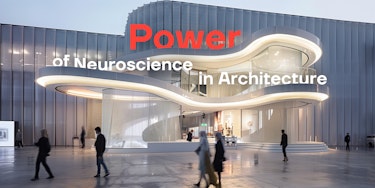Architecture is often perceived as a discipline driven by creativity and aesthetics, where form and function merge to create spaces that inspire and shelter. However, a deeper understanding of how these spaces influence human behaviour, cognition, and emotions has emerged through the interdisciplinary field of neuroscience. Neuroscience and architecture, when combined, offer a profound insight into how our brains interact with the built environment, making it possible to design spaces that go beyond mere physical utility to enhance mental and emotional well-being.
At the heart of this exploration is the concept of neuroarchitecture, which studies the interaction between architectural design and the human nervous system. This concept has gained significant traction as architects and designers seek to create environments that not only fulfil practical needs but also resonate with the psychological and emotional states of the people who inhabit them.
Workplace Design
The workplace is an environment where people spend a significant portion of their lives, making it crucial that these spaces support not only productivity but also well-being. Traditional office designs often prioritized efficiency over employee satisfaction, leading to spaces that are functional but not necessarily conducive to creativity or comfort. However, with the advent of neuroscience-informed design, the focus has shifted towards creating workplaces that align with the cognitive and emotional needs of employees.
One of the key findings from neuroscience is the impact of environmental stressors on cognitive function. Factors such as noise, poor lighting, and lack of privacy can lead to increased stress levels, which in turn reduce focus and productivity. On the other hand, environments that provide a sense of control, comfort, and natural elements can enhance cognitive performance and job satisfaction.
Moreover, personalized workstations that cater to individual preferences in lighting, temperature, and acoustics are becoming increasingly popular. Neuroscience shows that when employees can control their environment, they feel more empowered and less stressed, leading to better work outcomes.

Credit: Metropolis Magazine
Healthcare Environments
Healthcare environments are perhaps the most critical areas where the application of neuroscience can have life-changing effects. The design of hospitals, clinics, and other medical facilities can significantly influence patient outcomes, staff efficiency, and overall satisfaction with care. Neuroscience provides valuable insights into how physical spaces can affect health, from reducing stress and anxiety to enhancing the healing process.
One of the most profound applications of neuroscience in healthcare design is the use of natural light. Studies have shown that patients with access to natural light recover faster, experience less pain, and have lower stress levels than those in artificially lit rooms. This is due to the way natural light regulates the body’s circadian rhythms, which are closely linked to mood and overall health.
Colour is another critical element in healthcare design. Neuroscience has revealed that certain colours can evoke specific emotional responses. For example, blues and greens are often associated with calmness and tranquillity, while reds and oranges can increase heart rate and agitation.
Furthermore, the layout and flow of a healthcare facility can greatly impact the efficiency of care delivery and the stress levels of both patients and staff. Neuroscientific studies have shown that clear wayfinding, the reduction of noise, and the creation of private, quiet spaces can significantly enhance the healthcare experience.

Credit: Healthcare Channel
Educational Spaces
The design of educational spaces plays a crucial role in shaping the learning experience. Neuroscience has provided valuable insights into how different aspects of the environment can influence cognitive function, memory retention, and overall engagement in students. These insights are particularly important in the context of modern education, where there is a growing emphasis on active learning, collaboration, and creativity.
One of the key factors in educational design is the role of natural light. Studies have consistently shown that students exposed to natural light perform better academically, as it improves concentration and reduces fatigue.
The layout of the classroom is another critical aspect influenced by neuroscience. Traditional rows of desks facing the front of the room are being replaced by more flexible arrangements that encourage collaboration and interaction. Circular or semi-circular layouts, for example, have been shown to promote a more inclusive and engaging learning experience. CUUB’s visual storytelling approach allows educators to explore these different configurations and their potential impact on student engagement.
Acoustics also play a significant role in educational spaces. Poor acoustics can lead to increased cognitive load as students struggle to hear and process information. Neuroscience suggests that reducing background noise and improving sound quality can enhance learning and reduce stress. In addition to classrooms, the design of common areas, libraries, and outdoor spaces also plays a role in the overall educational experience. Neuroscience has shown that environments that provide opportunities for relaxation, social interaction, and connection with nature can reduce stress and enhance creativity.

Credit: eSchool News
Residential Design
The home is where we seek refuge, relaxation, and connection with loved ones. As such, the application of neuroscience to residential design can have a profound impact on our quality of life. Neuroarchitecture in the home focuses on creating spaces that reduce stress, promote relaxation, and enhance social interactions, ultimately leading to a more harmonious living environment.
One of the key principles of neuroarchitecture in residential design is the use of natural materials and elements. Neuroscience has shown that materials such as wood, stone, and natural fibers can evoke feelings of warmth, comfort, and connection to nature.
Lighting is another critical element in residential design. The use of natural light, combined with carefully designed artificial lighting, can create a dynamic and adaptable living space. Neuroscience suggests that varying light levels throughout the day can support the body’s natural rhythms, promoting better sleep and overall well-being.
Spatial planning also plays a significant role in neuroarchitecture. Open floor plans that promote flow and connectivity between different areas of the home can enhance social interactions and reduce feelings of isolation. However, it’s also important to include private spaces where individuals can retreat and recharge.
Furthermore, the integration of outdoor spaces into residential design is another important consideration. Neuroscience has shown that access to nature can reduce stress, improve mood, and even enhance cognitive function.

Credit: Biofilico
Urban Planning
On a macro scale, the principles of neuroscience can also be applied to urban planning, where the design of cities and neighbourhoods has a profound impact on the mental health and well-being of their inhabitants. Urban environments that are designed with the human experience in mind can promote social interaction, reduce stress, and foster a sense of community, all of which are critical for a thriving urban population.
One of the key aspects of neuroscience-informed urban design is the concept of walkability. Cities that are designed to be walkable, with easy access to amenities, green spaces, and public transportation, promote physical activity and reduce reliance on cars, which in turn reduces stress and promotes social interaction.
Access to nature is another critical element in urban design. Neuroscience has shown that green spaces, even small ones, can have a significant positive impact on mental health. Parks, greenways, and urban forests provide residents with opportunities for recreation, relaxation, and social interaction, all of which contribute to a healthier urban environment.
The human scale of buildings and streets is another important consideration. Neuroscience suggests that environments that feel too vast or imposing can create feelings of anxiety and disconnection. Conversely, human-scale environments, where buildings and public spaces are designed to be more relatable and approachable, can promote a sense of comfort and belonging.
Finally, the integration of public art and cultural elements into urban design can also enhance the mental and emotional well-being of city dwellers. Neuroscience has shown that exposure to art and culture can stimulate the brain, reduce stress, and enhance overall happiness.

Credit: ArchDaily
The fusion of neuroscience and architecture represents a transformative approach to designing spaces that truly cater to human needs. By understanding how the brain responds to different design elements, architects and designers can create environments that not only fulfil practical functions but also enhance mental and emotional well-being.
Whether it's in the design of workplaces, healthcare facilities, educational institutions, residential spaces, or entire urban environments, the application of neuroscience offers valuable insights that can improve the quality of life for all who use these spaces
